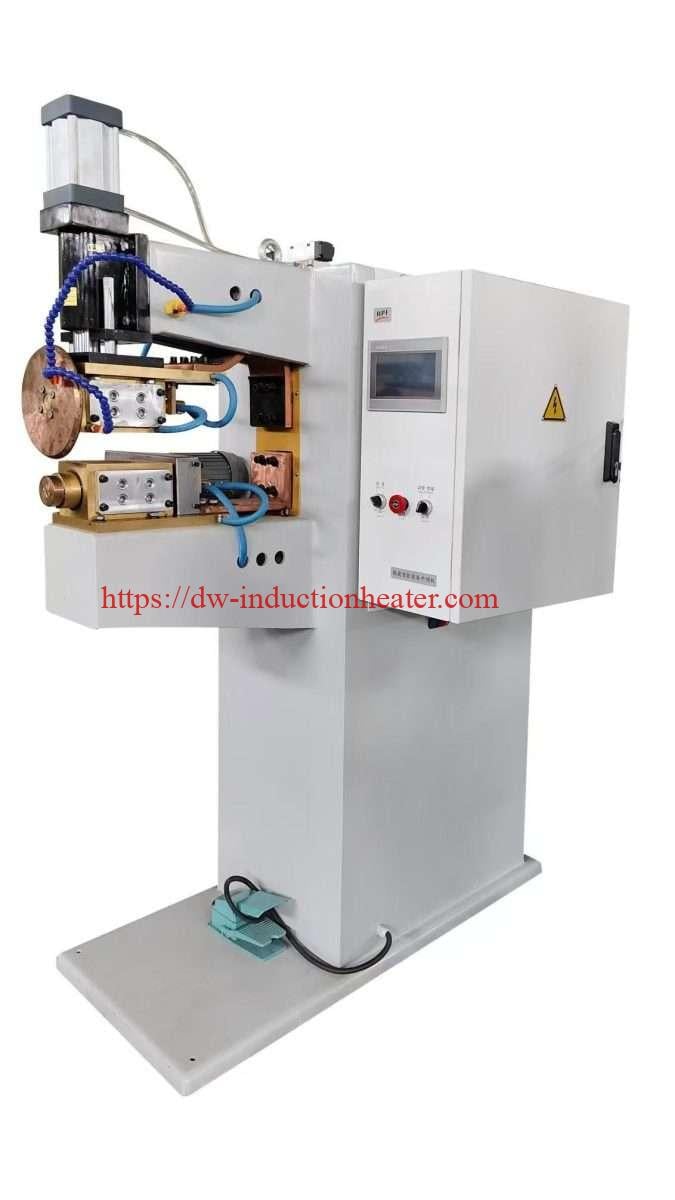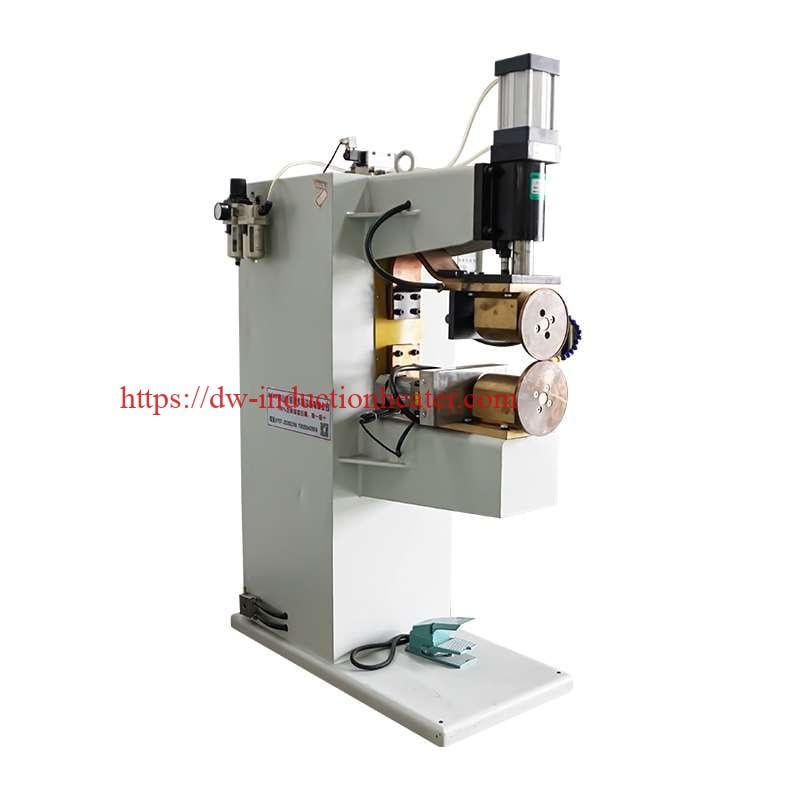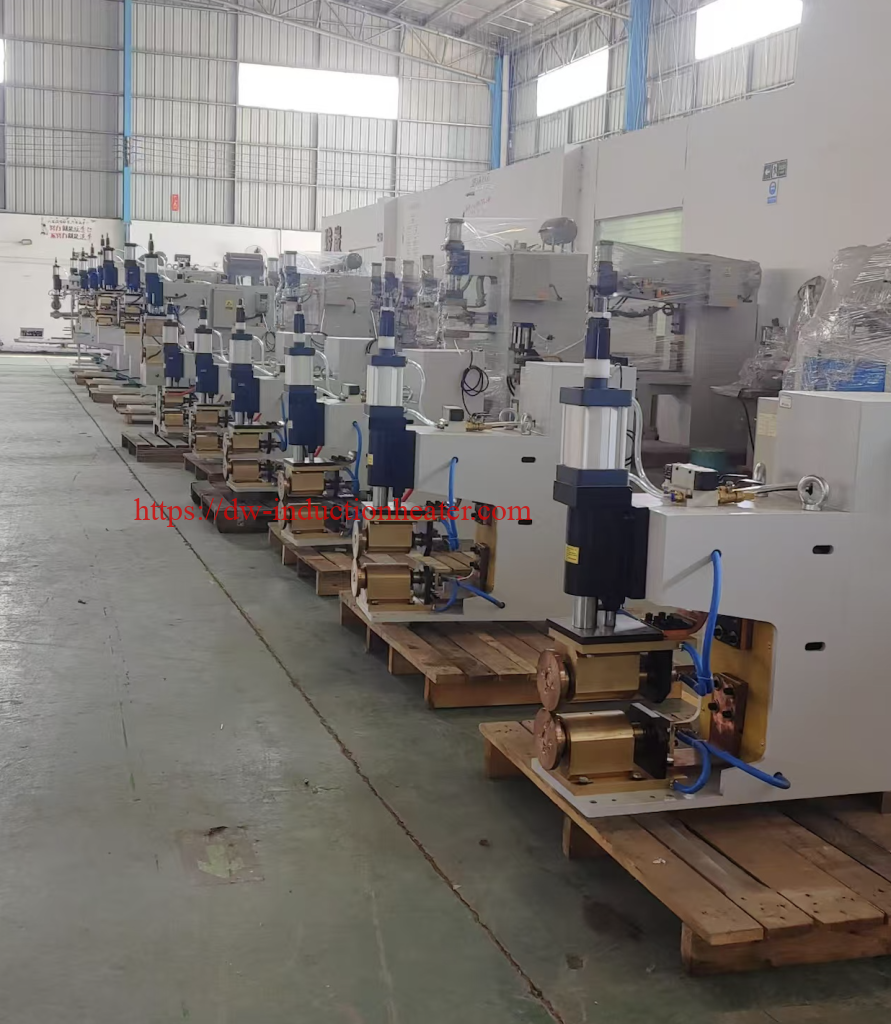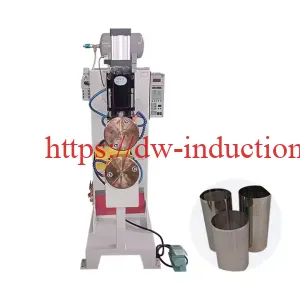-
1/5

-
2/5

-
3/5

-
4/5

Resistance Seam Welding Machines – Seam Welders For Sealing Metal Tanks With Airtight and Liquidtight
Resistance Seam Welding Machines: Seam Welders for Sealing Metal Tanks with Airtight and Liquidtight Integrity
Resistance seam welding machines play an essential role in the manufacturing sector, particularly when it comes to creating airtight and liquidtight seals. These machines are indispensable for industries that demand high-quality metal tanks, ensuring their structural integrity and leak-proof performance. In this comprehensive guide, we will cover everything you need to know about resistance seam welding machines and their applications in sealing metal tanks to help optimize manufacturing processes.
Table of Contents
Introduction to Resistance Seam Welding Machines for Precision Metal Sealing
How Seam Welding Works: A Basic Overview of Principles and Science
Primary Applications of Seam Welding Machines in Tank Manufacturing
Key Features and Components of Resistance Seam Welders
4.1 Roller Electrodes: The Foundation of Seam Welding
4.2 Current Control and Heat Management Systems
4.3 Automated and Manual Options for Optimal Precision
Recommended Welding Current for Materials
Seam Welding Wheel Speed vs Frequency
Advantages of Seam Welding for Airtight and Liquidtight Metal Tanks
Types of Resistance Seam Welding Machines Available
6.1 Conventional Resistance Seam Welders
6.2 Micro Resistance Seam Welders for Thin Metals
6.3 Automated Welding Systems for High Production Rates
Materials Commonly Welded with Resistance Seam Welders
Factors to Consider When Selecting a Seam Welding Machine for Tanks
Maintenance Tips for Seam Welding Machines to Guarantee Longevity
Future Trends in Resistance Seam Welding Technology
FAQs on Resistance Seam Welding Machines for Metal Tanks
Introduction to Resistance Seam Welding Machines for Precision Metal Sealing
Resistance seam welding (RSW) is a cutting-edge manufacturing process focused on joining metal sheets and fabricating durable, leak-proof structures. This technology utilizes precise electrical currents in combination with hydraulic pressure to create seamless, continuous welds along overlapping metal sheets. The goal? Achieve a consistent, airtight, and liquidtight seal that meets the rigorous standards required in industries such as automotive, aerospace, food processing, and industrial storage.
When it comes to producing and sealing metal tanks, resistance seam welding machines stand out thanks to their ability to bond ferrous and non-ferrous materials efficiently and reliably. From fuel tanks to pressure vessels, these machines serve as the backbone of industries where quality seals are paramount.
How Seam Welding Works: A Basic Overview of Principles and Science
Resistance seam welding is based on the principle of resistance heating: when electrical current flows through the interface of two overlapping metals, heat is generated as a result of the resistance to the flow of current. This heat, combined with compression applied through rotating roller electrodes, fuses the metals together along a seam.
Here’s a step-by-step breakdown of the resistance seam welding process:
- Preparation of Workpiece: Two pieces of metal, typically overlapping sheets, are positioned on the roller electrodes.
- Application of Current: An electrical current passes through the points of contact, generating heat sufficient to melt and fuse the materials.
- Electrode Pressure: Roller electrodes apply consistent pressure to maintain contact and ensure uniform weld quality.
- Steady Movement: The rollers move along the weld path, forming either a continuous seam or a series of tightly spaced spot welds that simulate a continuous line.
The result is a strong, uniform joint that can withstand pressure, corrosion, and extreme environmental conditions, making it ideal for sealing tanks holding gases or liquids.
Primary Applications of Seam Welding Machines in Tank Manufacturing
Resistance seam welders are favored across a wide range of industries that require precision sealing. Some of the notable applications include:
- Fuel Tanks: Creating leak-proof seals for automotive, aerospace, and industrial tanks.
- Food and Beverage Containers: Ensuring airtight joints for liquid-tight storage and transportation of products.
- Storage Tanks: Manufacturing liquid and gas storage tanks with high durability for industrial applications.
- Battery Casings: Seam welding of steel and nickel in battery manufacturing to ensure performance and insulation.
- HVAC Systems: Sealing ducts, pipes, and tanks for heating, ventilation, and air conditioning.
Key Features and Components of Resistance Seam Welders
4.1 Roller Electrodes: The Foundation of Seam Welding
The roller electrodes are the heart of any seam welding machine. These precision-engineered components rotate along the seam, providing both the pressure and electrical current required for welding metal sheets. The material and dimensions of the electrodes can be customized to suit specific welding applications, ensuring consistent results for a variety of metals and thicknesses.
4.2 Current Control and Heat Management Systems
Maintaining precise control over electrical current is critical for achieving consistent results. Advanced seam welders come equipped with programmable controls to adjust the current according to metal type, sheet thickness, and weld speed. Heat management systems also ensure that overheating or thermal distortion is minimized, preventing damage to workpieces.
4.3 Automated and Manual Options for Optimal Precision
Resistance seam welding machines are available in automated configurations for mass production settings, as well as manual machines suited for specialty work. Automated systems leverage robotic guidance and sensors to deliver precise, repeatable results, maximizing efficiency and maintaining consistent quality.
 Recommended Welding Current for Materials
Recommended Welding Current for Materials
| Material Type | Thickness (mm) | Welding Current (kA) | Electrode Force (kN) | Weld Speed (m/min) |
| Mild Steel | 0.5 – 1.0 | 5 – 8 | 1.5 – 3.0 | 2 – 6 |
| Stainless Steel | 0.5 – 1.0 | 4 – 7 | 1.8 – 3.2 | 1.5 – 4 |
| Aluminum Alloy | 1.0 – 2.0 | 10 – 18 | 3.0 – 6.5 | 1 – 3 |
| Galvanized Steel | 0.6 – 1.2 | 6 – 10 | 1.7 – 3.5 | 1.5 – 4 |
| Copper Alloy | 0.5 – 1.5 | 5 – 10 | 2.0 – 4.0 | 0.5 – 2 |
Product Specifications
| Parameter | ||||||||
| Model | Input voltage
/V |
Rated capacity
/KVA |
Rated Frequency
/HZ |
Rated duty cycle
/% |
Arm Length
/MM |
Electrode stroke
/MM |
Cooling water consumption
/L/min |
Max welding capacity (low carbon steel two block welding) /MM |
| FN-25 | 380V | 25 | 50/60 | 50 | 350 | 50 | 20 | 0.3+0.3 |
| FN-40 | 40 | 350 | 50 | 30 | 0.6+0.6 | |||
| FN-50 | 50 | 380 | 60 | 30 | 0.8+0.8 | |||
| FN-63 | 63 | 380 | 60 | 30 | 1.0+1.0 | |||
| FN-80 | 80 | 400 | 75 | 30 | 1.2+1.2 | |||
| FN-100 | 100 | 400 | 75 | 40 | 1.5+1.5 | |||
| FN-160 | 160 | 400 | 75 | 40 | 1.8+1.8 | |||
| FN-200 | 200 | 400 | 75 | 40 | 2.0+2.0 | |||
Wheel Electrode Guidelines
| Material To Weld | Electrode Material | Hardness (HV) | Diameter of Electrode Wheel (mm) | Thickness of Electrode Disk (mm) |
| Mild Steel | Copper | 200-250 | 100 – 200 | 6 – 8 |
| Stainless Steel | Cu-Cr Alloy | 300-350 | 80 – 150 | 5 – 7 |
| Aluminum and Aluminum Alloys | Cu-Be Alloy | 250-300 | 120 – 250 | 8 – 12 |
Weld Parameters
| Parameter | Typical Range |
| Weld Force | 1.5 kN – 6.0 kN |
| Weld Current | 2 kA – 20 kA |
| Weld Time | 0.1 sec – 2.0 sec |
| Coolant Flow Rate | 2 – 4 liters/min (per electrode) |
| Electrode Tip Pressure | 0.4 MPa – 0.8 MPa |
| Sheet Overlap Width | 5 mm – 15 mm |
Surface Preparation
| Material | Required Surface Finish | Cleaning Process |
| Mild Steel | Free of rust, oil, or paint | Mechanical brushing, degreasing |
| Stainless Steel | Free of oxide layer | Chemical cleaning, polishing |
| Aluminum Alloy | Free of oxide and oils | Abrasion and solvent cleaning |
| Galvanized Steel | Free of grease or heavy coatings | Mild abrasive cleaning |
Cooling Requirements
| Component | Cooling Method | Flow Rate (L/min) | Temperature Limit (°C) |
| Electrode Wheel | Water Cooling | 3 – 5 | <35 |
| Transformer | Water or Air Cooling | 4 – 6 | <50 |
| Current Conductors | Water Cooling | 2 – 4 | <40 |
Seam Welding Wheel Speed vs Frequency
| Frequency (Hz) | Maximum Seam Welding Speed (m/min) |
| 50 Hz | 1.5 – 3.0 |
| 60 Hz | 2.0 – 4.0 |
| 400 Hz | 5.0 – 12.0 |
 Advantages of Seam Welding for Airtight and Liquidtight Metal Tanks
Advantages of Seam Welding for Airtight and Liquidtight Metal Tanks
Seam welding provides numerous benefits over other welding techniques, making it the preferred option for sealing tanks.
- Superior Airtight and Watertight Integrity: The continuous weld ensures no gaps or leaks in sealed products.
- Strength and Durability: Welded seams are designed to withstand high pressures and environmental factors, such as corrosion.
- Speed: Automation and precision mechanisms enable rapid production without sacrificing quality.
- Cost-Effectiveness: Reduced material waste, high efficiency, and consistent quality lower production costs over time.
- Versatility: Suitable for both ferrous and non-ferrous metals, including steel, aluminum, copper, and their alloys.
Types of Resistance Seam Welding Machines Available
6.1 Conventional Resistance Seam Welders
These machines are ideal for general-purpose applications where standard sheet metal thicknesses need continuous welds.
6.2 Micro Resistance Seam Welders for Thin Metals
Specialty machines designed to weld thin or delicate materials without causing distortion. They are frequently used in microelectronics, medical devices, and battery manufacturing.
6.3 Automated Welding Systems for High Production Rates
In high-volume manufacturing environments, automated resistance seam welding systems are the gold standard. These machines integrate advanced robotics and AI for optimized welding precision.
Materials Commonly Welded with Resistance Seam Welders
- Stainless Steel: Popular for food, beverage, and industrial tanks.
- Aluminum: Used in lightweight aerospace and automotive applications.
- Nickel and Nickel Alloys: Preferred in battery casings.
- Copper: Common in plumbing and HVAC-related applications.
Factors to Consider When Selecting a Seam Welding Machine for Tanks
- Material Type: Choose a machine designed to handle the specific metals used in your products.
- Thickness Range: Match the machine’s capacity with the thickness of your workpieces.
- Automation Needs: Determine whether you require manual or fully automated systems.
- Electrical and Cooling Systems: Ensure compatibility with your facility’s infrastructure.
- Budget and ROI: Analyze long-term savings through reduced downtime and increased production efficiency.
Maintenance Tips for Seam Welding Machines to Guarantee Longevity
Proper care of your seam welding equipment ensures optimal performance and extended lifespan:
- Regularly inspect roller electrodes and replace worn-out components.
- Monitor current flow and calibrate control systems as needed.
- Keep cooling systems clean to prevent overheating.
- Perform routine cleaning of weld surfaces to avoid contamination.
- Train operators on machine-specific maintenance routines.
Future Trends in Resistance Seam Welding Technology
The future of resistance seam welding will likely involve further automation, integration of AI-enhanced process optimization, and the use of advanced materials in electrode design to prolong lifespan and enhance efficiency. With sustainability becoming a growing concern, energy-efficient systems are also expected to dominate the market.
FAQs on Resistance Seam Welding Machines for Metal Tanks
- What is the main purpose of resistance seam welding machines?
Resistance seam welding machines are designed to join metal sheets seamlessly, creating airtight and liquidtight seals critical for storage tanks, ducts, and containers. - Can resistance seam welding be used on all types of metals?
While it is versatile, its applicability depends on the machine’s configuration. Common materials include steel, aluminum, stainless steel, and copper alloys. - How does resistance seam welding differ from spot welding?
Spot welding creates individual weld points, while seam welding generates a continuous watertight or airtight line of weld. - What industries benefit the most from resistance seam welding?
Key industries include automotive, aerospace, HVAC, food processing, and energy sectors. - What are the primary advantages of automated seam welding machines?
Automation enhances precision, consistency, production speed, and reduces manual labor costs.
Conclusion
Resistance seam welding machines are a cornerstone of modern manufacturing, offering unmatched precision, strength, and efficiency for sealing metal tanks with airtight and liquidtight quality. By choosing the right configuration, maintaining the equipment properly, and staying ahead of technological advancements, manufacturers can capitalize on the full potential of seam welding to produce durable, leak-proof tanks that meet industrial demands. Whether you’re venturing into high-volume production or handling specialty projects, these machines are a valuable investment that ensures long-term success.





